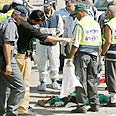
A year of relative quiet
Only six suicide attacks took place between October 2004 and today. In 2002, the year that marked the intifada’s zenith, 60 suicide attacks hit the country. Meanwhile, number of shooting attacks and firing of Qassam rockets from Gaza rises. Is the relative calm a sign of a quasi-hudna? The Shin Bet is skeptical
Since September 2000, when the first disturbances occurred on the Temple Mount, 144 suicide attacks were executed by 161 suicide bombers against Israeli targets. 515 Israelis were killed in these attacks, and 3,428 were injured.
In comparison to the previous four years of Palestinian uprising, the last year has witnessed a decline in suicide attacks. The Shin Bet recorded 6 suicide attacks in that period compared to 60 in 2002, 26 in 2003, and 13 in 2004.
By contrast the number of shooting attacks has risen in 2005 in comparison to previous years. Overall, 1,333 shooting attacks took place this year, while 1,198 were recorded in 2004.
The same trend has been observed in the figures on Qassam rockets fired from the Gaza Strip into Israel. Overall, 241 such attacks occurred this year in comparison to 159 last year and 103 in 2003.
All in all, 26,159 terror attacks against Israeli targets were recorded over the last five years, during which 1,064 Israelis lost their lives and 6,089 got injured.
The fifth year of the conflict has brought about significant changes, especially with the death of Yasser Arafat in November 2004, which led to the rise of Mahmoud Abbas to power, a development equivalent to “regime change,” so at least the Shin Bet believes.
Calm? Not for sure
On January 22, 2005 the Palestinians declared the beginning of a "Tahadia" – a calm period, in which Palestinian Authority Chairman Mahmoud Abbas attempted to reach an agreement with terror organizations.
The calm did not lead to a halt in terrorist attacks, despite an apparent decrease in the number of attacks compared to the previous years of conflict. Thus, from September 29, 2004 until September of the following year 3,530 attacks were carried out, in which 57 Israelis were killed and 516 were injured, compared to 3,877 attacks carried out on the fourth year of conflict, in which 135 Israelis were killed and another 567 injured.
Security establishment officials say that while Islamic Jihad had apparently accepted the calm period understandings, it in fact continued to send suicide bombers to Israel. On February 2005 a terrorist attack was carried out in Tel Aviv, and in July 2005 in Netanya.
Hamas allegedly maintained the understandings but developed a type of "balance," in which any Israeli operation perceived as "illegitimate," such as attacking wanted Palestinians, resulted in a terror response against Israel – particularly by means of shooting rockets and mortar shells at Israeli communities.
Meanwhile, behind the scenes Hamas was involved in assisting different terror organizations to carry out attacks.
Shin Bet officials say that once Israel left Gaza a state of anarchy materialized in the Strip, and the Palestinian Authority had proved its total inability to control the situation. The Philadelphi route was breached, despite the agreement with Egypt, and Hamas, along with other terror organizations, took advantage of the opportunity to smuggle massive amounts of weapons.
Within a few days approximately 3,000 guns and almost a million and a half rounds of ammunition were smuggled. In addition, over 150 launchers and rockets, hundreds of kilograms of explosives and dozens of guns were transferred into Gaza from Egypt.










